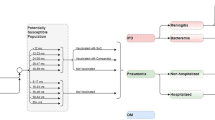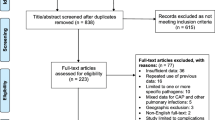Abstract
Parapertussis leads to similar symptoms as pertussis, both being caused by bacteria from the genus Bordetella. Poland does not routinely diagnose nor conduct surveillance for parapertussis. We estimated parapertussis incidence and determined predictors of parapertussis diagnosis in the Polish population. Between July 2009 and April 2011, we conducted a prospective cohort study among patients attending 78 general practices. We included patients aged ≥3 years, with cough lasting >2 weeks, interviewed patients and collected a nasopharyngeal swab. We confirmed cases by real-time PCR. We estimated parapertussis incidence rates by dividing the number of cases by the summed person-time of observation in respective practices. We assessed predictors of PCR-confirmed parapertussis by comparing cases with patients testing negative. Using logistic regression, we calculated odds ratios (ORs) and 95 % confidence intervals (95%CI). We identified 78 cases among 1,231 patients meeting inclusion criteria. The incidence rate was 39/100,000 person-years (95%CI 31–49). The highest rates (140/100,000; 95%CI 74–239), were among children 3–5 years of age and the lowest (24/100,000; 95%CI 13–40) among persons aged 20–39 years of age. Boys aged 3–5 years (7.1; 2.1–25.3) and women aged >40 years (4.1; 1.4–11.7) or living in crowded households (4.3; 1.4–12.9) or contacting persons with prolonged cough (2.3; 1.1–4.5) were more likely to be diagnosed. Our results suggest that laboratory diagnosis could be prioritized for children in the preschool age and women aged over 40 who were referred to their GP with prolonged cough. In the absence of vaccine, post-exposure prophylaxis for close contacts of parapertussis cases could an adequate preventative measure.
Similar content being viewed by others
References
American Academy of Pediatrics, Committee on Infectious Diseases (2000) Pertussis. In: Pickering LK (ed) Red Book: Report of the Committee on Infectious Diseases, 25th edn. Ill: American Academy of Pediatrics, Elk Grove Village, pp 435–448
Wirsing von König CH, Finger H (1994) Role of pertussis toxin in causing symptoms of Bordetella parapertussis infection. Eur J Clin Microbiol Infect Dis 13(6):455–458
Cherry JD, Seaton BL (2012) Patterns of Bordetella parapertussis respiratory illnesses: 2008–2010. Clin Infect Dis 54(4):534–537
Bergfors E, Trollfors B, Taranger J, Lagergård T, Sundh V, Zackrisson G (1999) Parapertussis and pertussis: Differences and similarities in incidence, clinical course, and antibody responses. Int J Infect Dis 3(3):140–146
Labor Enders (2014) Labordiagnostik von Infektionen mit Bordetellen. http://www.labor-enders.de/227.98.html. Accessed 25 July 2014
Linnemann CC, Perry EB (1977) Bordetella parapertussis. Recent experience and a review of the literature. Am J Dis Child 131:560–563
Libster R, Edwards KM (2012) Re-emergence of pertussis: what are the solutions? Expert Rev Vaccines 11(11):1331–1346
Lautrop H (1971) Epidemics of parapertussis. 20 years’ observations in Denmark. Lancet 1:1195–1198
Lautrop H (1958) Observations on parapertussis in Denmark, 1950–1957. Acta Pathol Microbiol Scand 43:255–266
Lanotte P, Plouzeau C, Burucoa C, Grélaud C, Guillot S, Guiso N, Garnier F (2011) Evaluation of four commercial real-time PCR assays for detection of Bordetella spp. in nasopharyngeal aspirates. J Clin Microbiol 49(11):3943–3946. doi:10.1128/JCM.00335-11
van der Zee A, Agterberg C, Peeters M et al (1993) Polymerase chain reaction assay for pertussis: simultaneous detection and discrimination of Bordetella pertussis and Bordetella parapertussis. J Clin Microbiol 31:2134–2140
Watanabe M, Nagai M (2004) Whooping cough due to Bordetella parapertussis: an unresolved problem. Expert Rev Anti Infect Ther 2(3):447–454
Kurova N, Njamkepo E, Brun D, Tseneva G, Guiso N (2010) Monitoring of Bordetella isolates circulating in Saint Petersburg, Russia between 2001 and 2009. Res Microbiol 161(10):810–815. doi:10.1016/j.resmic.2010.09.013
Baće A, Duancić V (1990) Review of the present status of prevention, prophylaxis and therapy of pertussis and parapertussis. Lijec Vjesn 112(7–8):262–268
Mertens PL, Stals FS, Steyerberg EW, Richardus JH (2007) Sensitivity and specificity of single IgA and IgG antibody concentrations for early diagnosis of pertussis in adults: an evaluation for outbreak management in public health practice. BMC Infect Dis 7:53
Organization WH (1999) Pertussis vaccines. WHO position paper. Wkly Epidemiol Rec 74(18):137–144
Borska K, Simkovicova M (1972) Studies on the circulation of Bordetella pertussis and Bordetella parapertussis in populations of children. J Hyg Epidemiol Microbiol Immunol 16:159–172
California Department of Public Health (2011) B. parapertussis infection: Public Health Recommendations. 2011 July. http://www.cdph.ca.gov/HealthInfo/discond/Documents/BParaPertussisInfectionPublicHealthRecommendations201107.pdf. Accessed 25 July 2014
The Department of Health Services of the State of Wisconsin (2011) Parapertussis Q and A (Interim guidelines 12/2011). http://www.dhs.wisconsin.gov/immunization/pdf/parapertussis.pdf. Accessed 25 July 2014
Rokosz N, Smietańska K, Rastawicki W, Jagielski M (2012) Seroprevalence of antibodies against lipopolysaccharides of Bordetella parapertussis in patients with prolonged cough in Poland. Med Dosw Mikrobiol 64(4):277–283
Stefanoff P, Paradowska-Stankiewicz IA, Lipke M, Karasek E, Rastawicki W, Zasada A, Samuels S, Czajka H, Pebody RG (2014) Incidence of pertussis in patients of general practitioners in Poland. Epidemiol Infect 142(4):714–723. doi:10.1017/S0950268813001684
Kösters K, Reischl U, Schmetz J, Riffelmann M, von König CH W (2002) Real-time LightCycler PCR for detection and discrimination of Bordetella pertussis and Bordetella parapertussis. J Clin Microbiol 40(5)):1719–1722
Mastrantonio P, Stefanelli P, Giuliano M et al (1998) Bordetella parapertussis infection in children: epidemiology, clinical symptoms, and molecular characteristics of isolates. J Clin Microbiol 36:999–1002
Liese JG, Renner C, Stojanov S, Belohradsky BH, Munich Vaccine Study Group (2003) Clinical and epidemiological picture of B pertussis and B parapertussis infections after introduction of acellular pertussis vaccines. Arch Dis Child 88(8):684–687
Bergfors E, Trollfors B, Taranger J, Lagergard T, Sundh V, Zackrisson G (1999) Parapertussis and pertussis: differences and similarities in incidence, clinical course, and antibody responses. Int J Infect Dis 3(3):140–146
Communicable Disease Control Unit of Manitoba (2007) Pertussis/parapertussis. Communicable disease management protocol. http://www.gov.mb.ca/health/publichealth/cdc/protocol/pertussis.pdf. Accessed 25 July 2014
Lautrop H (1971) Epidemics of parapertussis. 20 years’ observations in Denmark. Lancet 1(7711):1195–1198
Maixnerová M (2003) The 2001 serological survey in the Czech Republic–parapertussis. Cent Eur J Public Health 11(Suppl):S23–S24
Wymann MN, Richard JL, Vidondo B, Heininger U (2011) Prospective pertussis surveillance in Switzerland, 1991–2006. Vaccine 29(11):2058–2065. doi:10.1016/j.vaccine.2011.01.017
Nuolivirta K, Koponen P, He Q, Halkosalo A, Korppi M, Vesikari T, Helminen M (2010) Bordetella pertussis infection is common in nonvaccinated infants admitted for bronchiolitis. Pediatr Infect Dis J 29(11):1013–1015
Gold R (2002) Your child’s best shot, a parent’s guide to vaccination, 2nd edn. Canadian Pediatric Society, Ottawa, pp 54–75
Acknowledgments
We thank all participants, GPs, nurses, laboratory and administrative staff who took part in this study. We thank Dr. Nicole Guiso from the Institut Pasteur for providing controls of the B. parapertussis control strain and for Magdalena Rzeczkowska and Kamila Forminska from NIZP-PZH for laboratory assistance. We would like to address special thanks to Dr. Magdalena Rosinska for helping in planning the study and analyzing the data and Dr. Yvan Hutin for his assistance in manuscript preparation.
Conflict of interests
The authors declare that they have no conflict of interests.
Author information
Authors and Affiliations
Corresponding author
Rights and permissions
About this article
Cite this article
Tomialoic, R., Stefanoff, P., Paradowska-Stankiewicz, I. et al. Incidence and factors predicting whooping cough due to parapertussis diagnosis among patients referred to general practitioners, Poland, 2009–2011. Eur J Clin Microbiol Infect Dis 34, 101–107 (2015). https://doi.org/10.1007/s10096-014-2214-8
Received:
Accepted:
Published:
Issue Date:
DOI: https://doi.org/10.1007/s10096-014-2214-8




